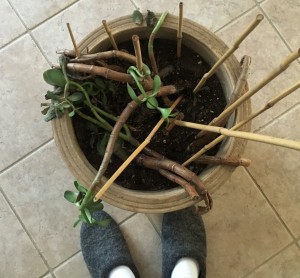Hello, fellow lovers of all things green,
 Some of my houseplants are desperate. The low humidity of the heated house has wreaked havoc. Plus, some of their pots are too tight, like my pants after the holidays. Thank goodness for stretchy jeans. Even if there were stretchy pots, the lack of nutrition and moisture from limited soil available to root-bound plants causes them stress. Then there’s root girdling, when roots wrap around each other, which must be as uncomfortable as too-tight jeans.
Some of my houseplants are desperate. The low humidity of the heated house has wreaked havoc. Plus, some of their pots are too tight, like my pants after the holidays. Thank goodness for stretchy jeans. Even if there were stretchy pots, the lack of nutrition and moisture from limited soil available to root-bound plants causes them stress. Then there’s root girdling, when roots wrap around each other, which must be as uncomfortable as too-tight jeans.
Signs of too-tight pots
If you see roots on the surface of your container or roots growing out of the drainage holes at the bottom, your plants need re-potting. Another sign is if your plants look bad. Even if your plant is wearing the right size pot, the soil grows tired and needs replenishing.
The best time to re-pot houseplants
Spring is the best time to re-pot indoor plants, just before they begin their peek growing cycle. Re-potting a plant causes stress, as does having to go up a size in jeans. Still, I wonder if the trauma of insufficient nutrients is worse than the stress of re-potting. In a nutshell, no. It’s best to re-pot when plants are actively growing. And best to stay in my too-tight jeans, which will inspire me to cut back on chocolate. Dang.
The interim intervention of houseplants in duress
As an interim intervention, I placed the plants that could fit in the kitchen sink and ran room-temperature water in the pots until the water ran through the bottom holes. Now, I use rainwater or melted snow for the nitrogen boost. (Check out Benefits of Watering with Rainwater). Be sure they completely stop draining before putting plants back on their saucers. Plants sitting in water or with too wet soil will cause root rot. Use the tub or shower for bigger plants. This is the second time since December I’ve performed this intervention. A monthly bath during the home heating season would have been kinder. It likely goes without saying to cut away the yellowing leaves and dead plant debris.
When to fertilize houseplants
Fertilizing indoor plants monthly is standard protocol, suspending feeding from November through February when plants are inactive. However, given the state of my root-bound babies, I’m resuming feeding now (early February) using fertilizer at half-strength as they’re beginning to wake up with the increasing light. I’ll provide comfort food every other week until it’s time to re-pot them come April. Then, at full strength, feeding once a month can return. But I MUST keep the consumption of chocolate in check. Dang.
Garden dilemmas? AskMaryStone@gmail.com and your favorite Podcast App.
There’s more to the story in the Garden Dilemmas Podcast:
Other posts you’ll enjoy:
About my Top-Heavy Aloe Dilemma
Benefits of Watering with Rainwater
Column updated 2/6/24



